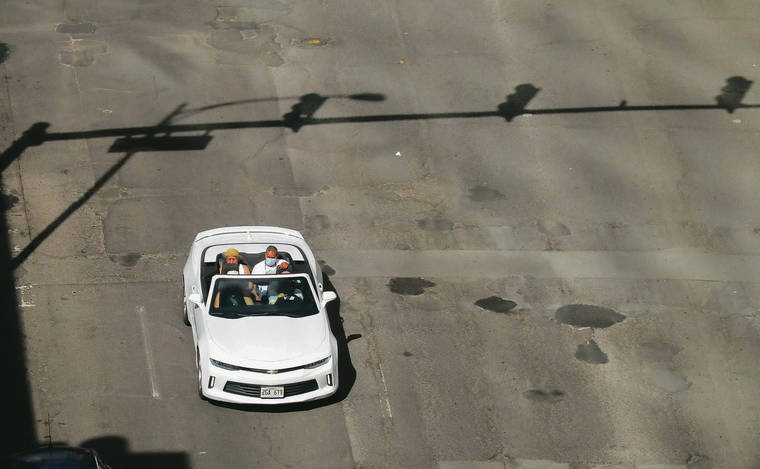Rising COVID-19 cases could push Oahu back to Tier 2

JAMM AQUINO / JAQUINO@STARADVERTISER.COM
There were 102 new coronavirus cases across the state as of Sunday. A convertible car with its top down showed passengers with and without masks Saturday in Honolulu.
If the number of positive COVID-19 cases on Oahu continues to climb, the island could move back to Tier 2 restrictions on business and social activities, which limit gatherings to five people.
Oahu has been in Tier 3, where gatherings of 10 people are allowed, since Feb. 25, and for a time appeared heading toward Tier 4, which would permit groups of 25 to gather.
But in the past week, new COVID-19 cases have been on a upward trend.
Sunday’s seven-day average case count for Oahu was 52, and the seven-day positivity rate was 1.9%.
To stay in Tier 3, Oahu must have an average seven-day case count below 50 and a positivity rate below 2.5%.
A seven-day average case count of 50 or more on two consecutive Wednesdays, the day the city takes its official measurement, would push Oahu back into Tier 2.
Don't miss out on what's happening!
Stay in touch with breaking news, as it happens, conveniently in your email inbox. It's FREE!
City spokesman Tim Sakahara said Sunday in an email that “Oahu is still in the Tier 3 metric of the reopening strategy.”
Sakahara did not speculate on future tier movement, but said that “the city monitors current conditions and recognizes there has been an uptick in positive COVID-19 cases over the past week on Oahu.”
“Public health is the priority and the city continues to work with the State Department of Health and health experts to assess current risks and make adjustments as needed,” he said.
Sakahara said the city continues “to safely reopen the economy allowing more people to return to work.”
But he said that “the community must also work together to prevent the spread of the virus by continuing to wear masks, remaining physically distanced and abiding by the rules of the reopening strategy.”
If Oahu meets Tier 2’s average case count for two Wednesdays in a row, Honolulu Mayor Rick Blangiardi could order it to revert back to Tier 2 for at least four weeks. The city doesn’t use test positivity rates as a metric to move backward.
More information regarding moving forward or backward on the tier system can be found at oneoahu.org/ reopening-strategy Opens in a new tab.
Oahu moved into the less restrictive Tier 3 of the city’s four-tier economic recovery plan after being in Tier 2 since Oct. 22, but since that time has seen its case counts and positivity rates increase.
Honolulu Mayor Rick Blangiardi on March 11 announced modifications to Tier 3, including allowing bars to reopen under the same conditions as restaurants and extending the curfew until midnight.
At the same time, Hawaii has seen a rush of spring break visitors, which could continue for another month or so. The spring break travel period traditionally opens about the second week of March and runs through about the fourth week of April.
Carl Bonham, executive director of the University of Hawaii’s Economic Research Organization (UHERO), said in a video message on covidpau.org that safely bringing back visitors is key to recovering Hawaii’s economy across the islands.
Bonham said Hawaii in January led the nation with the highest unemployment rate at 10.2% and the highest increase.
He said the best way to get the 70,000 or so people who are still unemployed back to work is to recover tourism, which in March has averaged more than 12,000 arrivals per day into the state, or about 40% of where the state was in 2019.
“As we get into the summer and we’ve vaccinated many more people nationally and in Hawaii, those numbers will continue to grow, and we’ll be able to get families back to work again,” he said.
But reopening the economy has been an incredible balancing act on all the islands, not just Oahu.
State Department of Health officials Sunday reported 102 new coronavirus infections statewide, bringing Hawaii’s total since the start of the pandemic to 29,408 cases.
State health officials reported no new coronavirus-related deaths as the statewide death toll remained at 462.
Health officials also said Sunday that of the state’s total infection count, 1,104 cases were considered active. Officials say they consider infections reported in the past 14 days to be a “proxy number for active cases.” The number of active cases in the state increased by 52 Sunday.
Health officials counted 6,549 new COVID-19 test results in Sunday’s tally, for a 1.5% statewide positivity rate. The state’s seven-day average positivity rate is 1.7%, according to the Hawaii COVID-19 Data dashboard.



